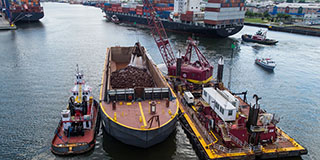When Great Lakes Dredge & Dock Co. fired up its 220’x56’x8’ cutter suction dredge Alaska off Savannah, Ga. Monday, it marked the climax to a nearly 17-year process of politics and planning.
The five-year, $706 million Savannah Harbor Expansion Plan is funded with 60% federal taxpayer money via the Corps of Engineers, and 40% bankrolled by Georgia state taxpayers. In a fiscally conservative state like Georgia, that says a lot about the value of maritime industry.
Great Lakes Dredge & Dock at work. Great Lakes photo.Deepening a 17-mile channel from the port to the open Atlantic and adding 5’ of minimum depth to 47’ all the way to the container port will keep bigger post-Panama Canal expansion ships and more cargo coming – and keep Savannah in the top tier of U.S. ports, backers say.
There is a scramble in the Sunbelt to get a lead on that business, with implications for the workboat industry in dredging and maintenance, ship assist, and tow work. Savannah surpassed Charleston, S.C., in shipping volume and with 3.1 million units in the fiscal year that ended in mid-2014, was second on the East Coast only to the sprawling New York-New Jersey port complex.
The Georgia Ports Authority plans to invest $1.3 billion in port infrastructure and grow cargo capacity to 6.5 million units a year by 2024.
South Carolina port boosters are not sitting still either. On the same day dredging began off Savannah, the Corps of Engineers approved plans to deepen Charleston’s harbor and channels. The project could potentially cost $509 million.
That plan would see Savannah’s deepening bet, and raise it, taking the harbor approach down from 45’ to 52’ depth. South Carolina Ports Authority president Jim Newsome has said that will make Charleston competitive with New York-New Jersey, where the Corps of Engineers is scraping the Arthur Kill channel between New Jersey and Staten Island down to 50’ depth.
Significantly, the pace of growth at the Southeast ports is quicker than that in New York and New Jersey, driven by both the Sunbelt population growth and manufacturers like Michelin and BMW. There’s competition in Florida too, with aggressive moves by Port Canaveral to get cargo and cruise traffic away from Miami.
For history’s lesson on what happens to ports that don’t keep pace, there is New England. The Corps of Engineers plan to deepen channels there to 47’ and 51’ will make Boston the only port in the region capable of accommodating modern container shipping.




